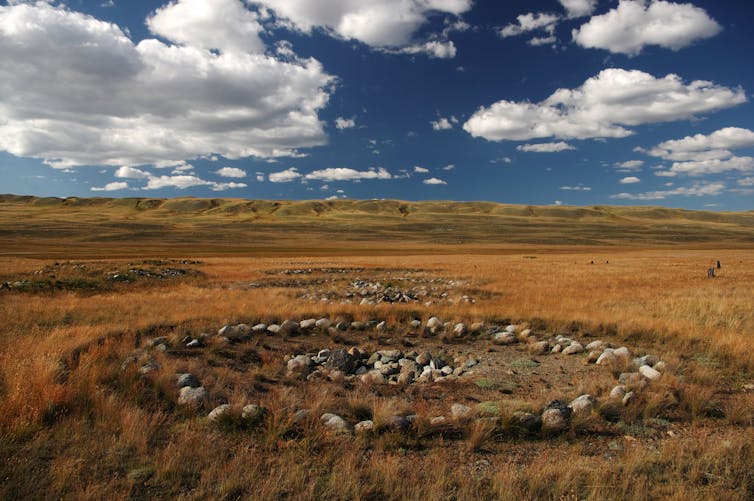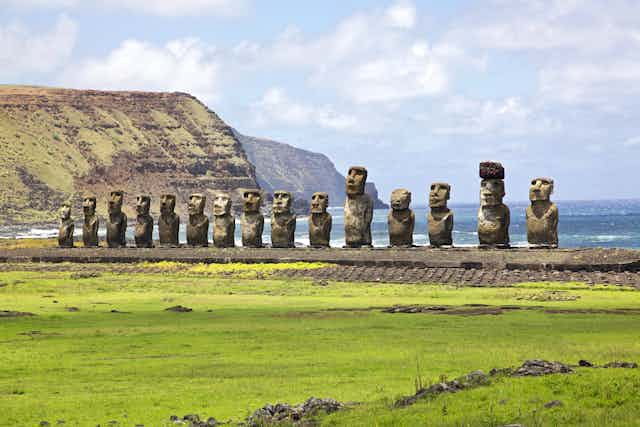Museums, archaeological sites and historical buildings are rarely included in conversations about climate change, which tend to focus on the wider impact and global threats to our contemporary world. Yet these threats impact everything, from local cultural practices to iconic sites of outstanding universal value. In light of this, it’s worth exploring the relationship between our heritage and the changing global climate in more detail.
More powerful storms, flooding, desertification and even the melting of permafrost are already destroying important sites at an alarming rate. While we race to preserve or record these places before they are lost forever, it is also the case that some sites – especially those that are or have been highly adaptable and flexible – can also be assets in understanding adaptation strategies more generally.
These questions are currently being explored by an expert working group, which we are part of. Our aim is to unpack the intersection between our changing climate and the world’s cultural heritage, specifically world heritage sites. Building on the Paris Agreement, which notes the importance of traditional and indigenous knowledge when thinking about adaptation strategies, we are exploring how global heritage can be used not only to stress urgency about the dangers and risks of climate change, but also as an asset to enforce community resilience and develop adaptation strategies for the future.
Melting permafrost
Take Russia’s Treasures of the Pazyryk Culture. Located in the Altai mountains, this landscape of burial mounds (kurgans) and rock carvings derive from the Scythian nomadic culture of 2,500 years ago. A few of the two- to four-metre tall stone mounds have been excavated in the past. They reveal an incredible array of artefacts, complex funerary practices, and (most famously) tattooed individuals – all preserved due to the sub-zero conditions.

The melting of permafrost due to rising temperatures is expected to significantly impact frozen tombs at the site by the middle of this century. The chemical and biological deterioration of the organic and inorganic contents, previously inhibited by the freezing conditions, is likely to accelerate rapidly, while associated ground movement could cause structural damage to the tombs themselves.
The threat to these tombs from rising temperatures has been met with efforts to survey and protect them. While many indigenous people and heritage conservators aim to preserve the burials without disturbing them, it is not yet clear if this can be achieved.

Rising waters
Elsewhere, rising sea waters and erosion are having a similarly disastrous impact. The Ruins of Kilwa Kisiwani in Tanzania, for example, are at considerable risk from the impact of increased surf, exacerbated by the loss of mangrove forestry on the island.
This site was founded in the ninth century and became a major trading centre by the 13th century. It was inscribed as a UNESCO world heritage site in 1981 as an exceptional testimony to the expansion of Swahili coastal culture, and to the spread of Islam in Africa in this period. Ongoing efforts are being made here to strengthen the sea wall protecting the site, and to encourage alternate land use strategies to increase natural protection. The area’s iconic heritage is helping to deliver important messages concerning climate change.

In Easter Island, meanwhile, rising sea levels and increasing storm surges are eroding the platforms (ahu) upon which famous statues (moai) are stood. Almost all of these statues are on the coast. It is very clear that climate change is having an adverse and worsening impact on these sites. This damage will destroy parts of the archaeological resource, including subsurface archaeological deposits that are particularly under-researched. The loss of these statues could have a significant negative impact on the tourism economy of Easter Island, affecting the livelihoods and resilience of the islanders.
Lessons from heritage
But we can learn a lot from some communities’ response to threat at such sites in the study of climate change resilience. While increased flooding and extreme weather conditions represent a considerable challenge globally, coastal and river communities have been living with (and adapting to) similar events for centuries.
A good example of this localised adaptation can be found on the river island of Majuli in the Brahmaputra River in Assam, India. Majuli is a landscape of both natural and cultural significance. The island is also home to over 30 ancient monasteries, known as sattras, which are repositories of both tangible and intangible culture.

Here, annual flooding has led to significant erosion of the river and the displacement of communities, many of which live outside of the protective levees constructed in recent years. Over hundreds of years, communities on Majuli have developed modular and portable building techniques using local materials including building on stilts. The river and its annual flooding have become part of the everyday experience of living on Majuli and is a part of the local worldview.
More permanent structures of the sattras are not immune to the impacts of the river and some have been moved up to five times over the last 300 years. These places and their associated cultural heritage have evolved to be portable, a valuable skill in a landscape which changes regularly.
It should be stressed that, even with these adaptations, the current pace of climate change is unprecedented and its impact on river and coastal communities will be disastrous. Yet, by better understanding places like Majuli, we will learn much about resilience and adaptation to the inevitable impacts of climate change.

